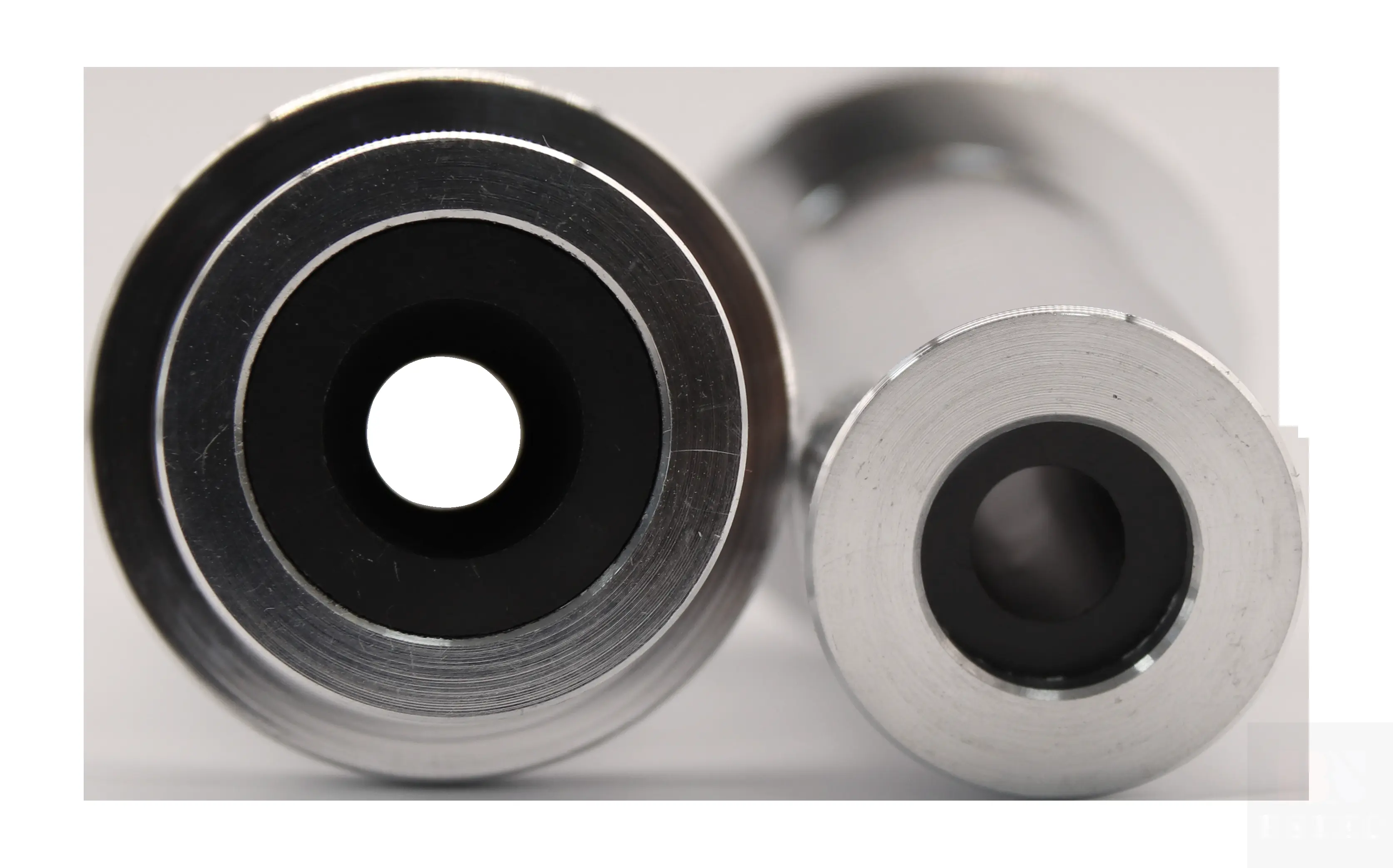ഉരച്ചിത്ര മെറ്റീരിയലുകളുടെയും വലുപ്പത്തിന്റെയും ആമുഖം
ആമുഖ്യംn ഉരവാക്കാത്തസ്ഫോടനം മെറ്റീരിയലുകളും വലുപ്പവും

ഉയർന്ന വേഗതയിൽ ഉപരിതലത്തിൽ മെറ്റീരിയലിനെ മുന്നോട്ട് കൊണ്ടുപോകുന്നതിലൂടെ സ്ഫോടന യന്ത്രങ്ങൾ വൃത്തിയുള്ളതും ആകൃതി അല്ലെങ്കിൽ പൂർത്തിയാക്കുക. സാധാരണയായി ഉപയോഗിക്കുന്ന ചില ഉരക്കങ്ങളിൽ ചിലത് ഉൾപ്പെടുന്നു:
ക്വാർട്സ് സാൻഡ്: ക്വാർട്സ് മണൽ തകർന്ന ക്വാർട്സ് കല്ലിൽ നിന്നാണ് നിർമ്മിച്ചിരിക്കുന്നത്, നല്ല കാഠിന്യവും റെസിസ്റ്റും ധരിക്കുന്നു. ഉരിപ്പുള്ള വ്യവസായത്തിൽ ഇത് ചെലവും വ്യാപകമായി ഉപയോഗിക്കുന്നു.
സ്റ്റീൽ ഗ്രിറ്റും സ്റ്റീൽ ഷോട്ടും: ഇവ ക്വാർട്സ് മണലിനേക്കാൾ കഠിനമാണ്, കൂടാതെ തുരുമ്പെടുക്കുന്ന അപ്ലിക്കേഷനുകൾക്കായി കൂടുതൽ ആക്രമണാത്മക ഉടമ്പടി നൽകുക, അല്ലെങ്കിൽ പെയിന്റിംഗിനായി മെറ്റൽ ഉപരിതലങ്ങൾ തയ്യാറാക്കുന്നു.
അലുമിനിയം ഓക്സൈഡ് (അലുമിന): അലുമിന ഉയർന്ന കാഠിന്യത്തിന് പേരുകേട്ടതാണ്, മാത്രമല്ല നനഞ്ഞതും വരണ്ടതുമായ സ്ഫോടീംഗ് പ്രക്രിയകൾക്കായി ഉപയോഗിക്കാം. ലോഹങ്ങൾ, ഗ്ലാസ്, മറ്റ് ഹാർഡ് ഉപരിതലങ്ങൾ എന്നിവ വൃത്തിയാക്കുന്നതിനും പൂർത്തിയാക്കുന്നതിനും ഇത് അനുയോജ്യമാണ്.
സിലിക്കൺ കാർബൈഡ്: ഏറ്റവും പ്രയാസമേറിയ ഉരച്ച രാജ്യങ്ങളിലൊന്നാണ് സിലിക്കൺ കാർബൈഡ്, കൂടാതെ ദ്രുതഗതിയിലുള്ള കട്ടിംഗ് പ്രവർത്തനം ആവശ്യമുള്ള ട്യൂഗർ ഇൻഡസ്ട്രിയൽ ആപ്ലിക്കേഷനുകൾക്കായി ഉപയോഗിക്കുന്നു.
ഗാർനെറ്റ്: ഗാർനെറ്റ് ഒരു പ്രകൃതിദത്ത ഉരച്ചിലേയാണ്, അത് കുറഞ്ഞ അളവിലുള്ള പൊടിപടലങ്ങൾ നൽകുന്ന ഒരു സ്വാഭാവിക നേട്ടമാണ്, അത് പാരിസ്ഥിതിക ആശങ്കകൾ പ്രധാനമാണ്.
വാൽനട്ട് ഷെല്ലുകളും കോൺ കോബ് ധാന്യങ്ങളും: ജൈവവസ്തുക്കൾ വാൽനട്ട് ഷെല്ലുകളെയും ധാന്യ കോബ് ധാന്യങ്ങളെയും പോലെ ഉപയോഗിക്കുന്നു.
ഗ്ലാസ് ബീറ്റ്സ്: ഗ്ലാസ് ബീഡുകൾ സുഗമമായ ഒരു ഫിനിഷ് സൃഷ്ടിക്കുന്നു, മാത്രമല്ല അവ പലപ്പോഴും നൊമിശയം, മിനുക്ക, പിന്നൽ പ്രവർത്തനങ്ങൾ എന്നിവയ്ക്കായി ഉപയോഗിക്കുന്നു.
പ്ലാസ്റ്റിക് മീഡിയ: കെ.ഇ.യുടെ ഉപരിതല പ്രൊഫൈലിൽ മാറ്റം വരുത്താതെ മലിനീകരിക്കുന്ന സ്ഫോടനത്തിന് പ്ലാസ്റ്റിക് ഉരസിവുകൾ ഉപയോഗിക്കുന്നു.
സ്റ്റെയിൻലെസ് സ്റ്റീൽ ഷോട്ട്: സ്റ്റെയിൻലെസ് സ്റ്റീലിനും മറ്റ് നാറോസിൻ-പ്രതിരോധശേഷിയുള്ള അലോയ്കൾക്കും സ്റ്റെയിൻലെസ് സ്റ്റീൽ ഷോട്ട് ഉപയോഗിക്കുന്നു, ഇത് അടിസ്ഥാന ഭൗതികത്തിന്റെ ഗുണവിശേഷതകൾ സംരക്ഷിക്കുന്നു.
കാർബൺ ഡൈ ഓക്സൈഡ് സ്നോ: പരമ്പരാഗത മാധ്യമങ്ങൾക്ക് പരിസ്ഥിതി സൗഹൃദ ബദലാണ്, അവശിഷ്ടങ്ങൾ അവശേഷിക്കാതെ കോട്ടിംഗുകളും മലിനീകരണങ്ങളും നീക്കംചെയ്യുന്ന മികച്ച കണികകൾ സൃഷ്ടിക്കുന്നതിന് ഇതാണ്.
പ്രോസസ്സ് ചെയ്ത മെറ്റീരിയൽ, ആവശ്യമുള്ള ഫിനിഷ്, പാരിസ്ഥിതിക പരിഗണനകൾ എന്നിവ ഉൾപ്പെടെ സ്ഫോടന പ്രവർത്തനത്തിന്റെ പ്രത്യേക ആവശ്യങ്ങളെ ആശ്രയിച്ചിരിക്കും ഉരച്ചിലുകൾ തിരഞ്ഞെടുക്കുന്നത്. ഓരോ ഉരച്ചിലിന് വ്യത്യസ്ത ആപ്ലിക്കേഷനുകൾക്ക് അനുയോജ്യമാക്കുന്ന സവിശേഷ സവിശേഷതകളുണ്ട്.

സ്ഫോടനം, സാൻഡ്ബ്ലാസ്റ്റിംഗ് മെഷീനുകളിൽ സാധാരണയായി ഉപയോഗിക്കുന്ന സ്ഫോടന മാധ്യമങ്ങൾ വ്യത്യസ്ത ആപ്ലിക്കേഷനുകളും ഉപരിതല തയ്യാറെടുപ്പുകളും ഉൾക്കൊള്ളാൻ വിവിധ വലുപ്പത്തിൽ വരുന്നു. ഉരച്ചിലിന്റെ വലുപ്പം നിർത്തിവയ്ക്കുന്നത് നിർത്തി സ്ഫോടന പ്രക്രിയയുടെ കാര്യക്ഷമതയെ കാര്യമാക്കുന്നു. സാധാരണ വലുപ്പങ്ങളുടെ ഒരു ചുരുക്കവിവരണം ഇതാ, അവയുടെ സാധാരണ ഉപയോഗങ്ങൾ:
നാടൻ ആരാധനകൾ: ഇവ സാധാരണയായി 20/40 മെഷ് വലുപ്പത്തേക്കാൾ വലുതാണ്. ഒരു ആഴത്തിലുള്ള പ്രൊഫൈലോ ആക്രമണാത്മക വൃത്തിയാക്കലോ ആവശ്യമുള്ള ഹെവി-ഡ്യൂട്ടി ആപ്ലിക്കേഷനുകൾക്ക് നാടൻ നാടൻമാരെ ഉപയോഗിക്കുന്നു. കട്ടിയുള്ള കോട്ടിംഗുകൾ, കനത്ത തുരുമ്പ്, സ്കെയിൽ എന്നിവയിൽ നിന്ന് അവ നീക്കംചെയ്യാൻ അവ ഫലപ്രദമാണ്. മികച്ച പെയിന്റിനോ കോട്ടിംഗ് സെഷീയോസിനോ ഉള്ള ഉപരിതലങ്ങൾ കൊതിക്കുന്നതും ടെക്സ്ചർ ചെയ്യുന്നതിനും നാടൻ സൃഷ്ടിവുകൾ ഉപയോഗിക്കാം.
ഇടത്തരം atsaestives: ഇവ 20/40 മെഷ് മുതൽ 80 മെഷ് വരെയാണ്. വൈദ്യുതിയും ഭൗതിക ഉപഭോഗവും തമ്മിൽ ഇടത്തരം atsasives ഒരു നല്ല ബാലൻസ് വാഗ്ദാനം ചെയ്യുന്നു. പൊതുവായ ക്ലീനിംഗ് ടാസ്ക്കുകൾക്ക് അവ അനുയോജ്യമാണ്, ഇടത്തരം കോട്ടോറിലേക്ക് വെളിച്ചം നീക്കംചെയ്യുന്നു, കൂടാതെ ഉപരിതലത്തിൽ ഒരു ഏകീകൃത ഫിനിഷ് നൽകുന്നു.
മികച്ച ഉരുകച്ചവെടുത്തത്: സാധാരണയായി 80 മെഷിനേക്കാൾ ചെറുത്, ഒരു മികച്ച ഫിനിഷ് ആവശ്യമുള്ള കൂടുതൽ അതിലോലമായ ജോലികൾക്കായി ഈ ഉറ്റുവാസികൾ ഉപയോഗിക്കുന്നു. ഇളം പെയിന്റ്, അല്ലെങ്കിൽ പാരയം, ആഴത്തിൽ നിന്ന് വിട്ടുപോകാതെ പെയിന്റിംഗിനായി ഉപരിതലങ്ങൾ തയ്യാറാക്കുന്നതുപോലെ അവയിൽ മാറ്റം വരുത്താതെ അവ ഉപരിതലങ്ങൾ വൃത്തിയാക്കാൻ അനുയോജ്യമാണ്. മിനുസമാർന്ന ഉപരിതല ഘടന നേടുന്നതിനുള്ള ഫിനിഷിംഗ് പ്രക്രിയയിലും മികച്ച ഉരച്ചിലുകളും ഉപയോഗിക്കുന്നു.
വളരെ മികച്ചതോ മൈക്രോ ഉരാക്കണങ്ങൾ: ഇവ 200 മെഷ്, ഫൈൻ എന്നിവയിൽ നിന്ന് ലഭിക്കും. സങ്കീർണ്ണമായ പ്രതലങ്ങൾ വൃത്തിയാക്കുകയും മിനുസപ്പെടുത്തുകയോ അല്ലെങ്കിൽ സെൻസിറ്റീവ് മെറ്റീരിയലുകൾ ഉണ്ടാക്കാതെ അവ വളരെ അതിലോലമായ ജോലിക്കായി ഉപയോഗിക്കുന്നു. ഗുരുതരമായ കോട്ടിംഗുകൾക്കുള്ള തയ്യാറെടുപ്പിലും വളരെ മികച്ച പുരോഗമിക്കുന്നവരും ഉപയോഗിക്കാം, അവിടെ ഉപരിതല പ്രൊഫൈൽ അങ്ങേയറ്റം ആകർഷകമായിരിക്കണം.
ഉരച്ച വലുപ്പത്തിന്റെ തിരഞ്ഞെടുപ്പ്, സ്ഫോടനം, ആവശ്യമുള്ള ഉപരിതല ഫിനിഷ്, സ്ഫോടന പ്രക്രിയയുടെ കാര്യക്ഷമത എന്നിവ ഉൾപ്പെടെ നിരവധി ഘടകങ്ങളെ ആശ്രയിച്ചിരിക്കുന്നു. സബ്സ്ട്രേറ്റ് കേടുപാടുകൾ കുറയ്ക്കുന്നതിന് കുറഞ്ഞ സമ്മർദ്ദങ്ങളിൽ ചെറിയ കണങ്ങൾക്ക് ഉപയോഗിക്കാൻ കഴിയും, അതേസമയം വലിയ കണങ്ങൾക്ക് ആവശ്യമുള്ള ഫലം നേടുന്നതിന് ഉയർന്ന സമ്മർദങ്ങൾ ആവശ്യമാണ്. കേടുപാടുകൾ അല്ലെങ്കിൽ കഴിവില്ലായ്മ വരുത്താൻ ഉപയോഗിക്കുന്ന സാൻഡ്ബ്ലാസ്റ്റിംഗ് ഉപകരണങ്ങളുമായി ഉരച്ച വലുപ്പം പൊരുത്തപ്പെടുന്നുവെന്ന് എല്ലായ്പ്പോഴും ഉറപ്പാക്കുക.













